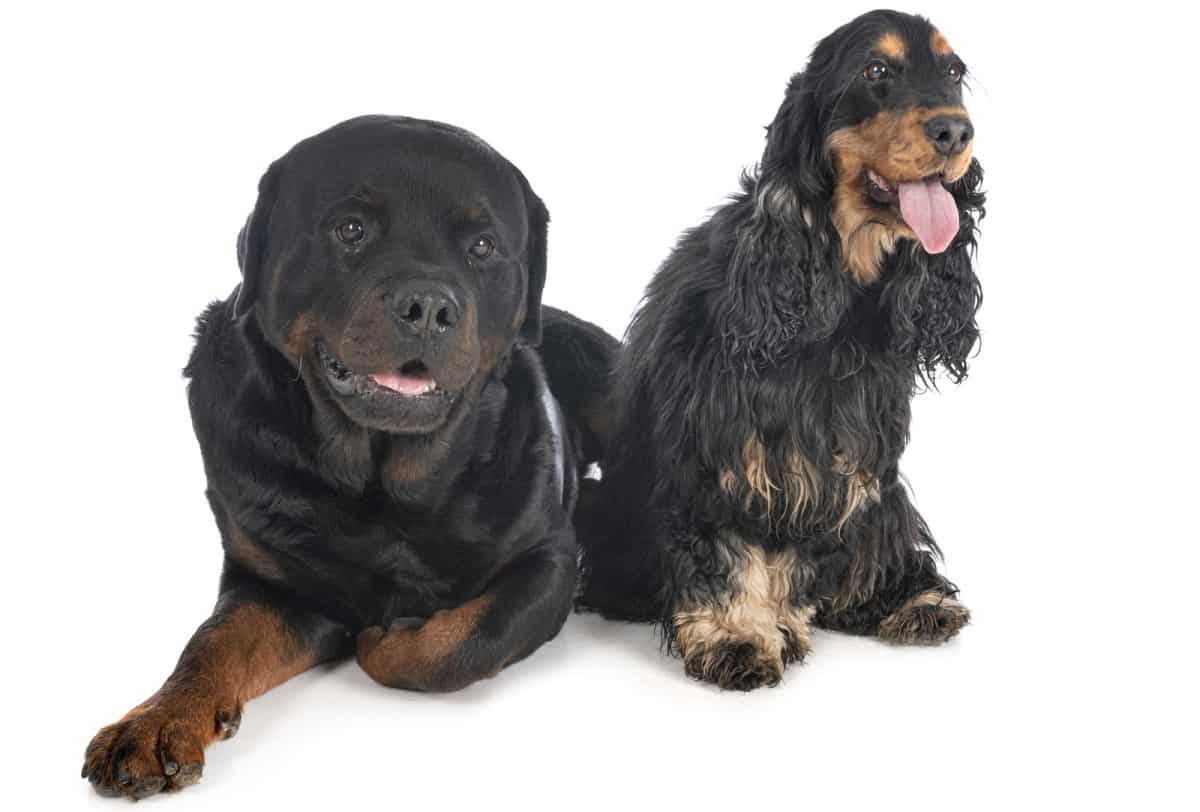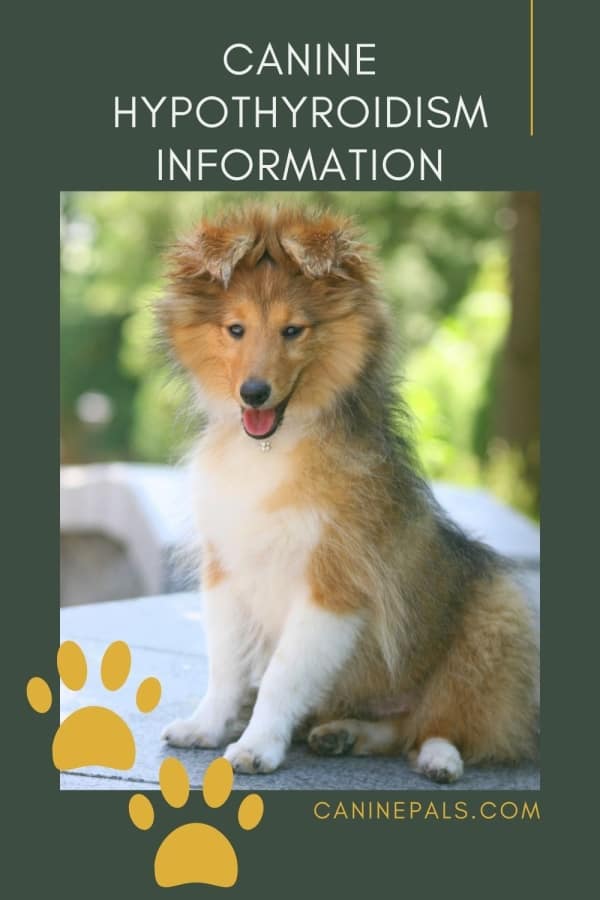Last Updated on March 22, 2021 by Denise Leo. Post first published on February 22, 2021.
Can dogs get thyroid problems? Unfortunately the answer is yes, dogs and thyroid issues are common. If your dog seems sluggish and has a puffy-looking appearance, it may mean he has problems with his thyroid.
What is Hypothyroidism in Dogs?
The thyroid gland produces various hormones including T3 (liothyronine) and T4 (levothyroxine) that help to maintain a normal metabolism canine hypothyroidism occurs when there’s a deficiency of the thyroid hormone.
Hypothyroidism happens to people as well as dogs. The thyroid hormone (also called thyroxine) affects virtually all organs in the body. The deficiency happens generally when your dog’s immune system destroys his thyroid gland. More than 95% of all cases occur as a result of the destruction of this important gland. This vital gland sits just under the throat. The technical name for this problem is autoimmune hypothyroidism in dogs.
Sometimes the gland simply wastes away with no known cause. This condition may be present when the puppy is born, in which case it can lead to a type of dwarfism. Cats may also face this problem but it’s much rarer. It may happen if the cat has been treated for hyperthyroidism with too high a dose of medication. Dwarfism is extremely rare in cats.
Risk Factors, Signs and Symptoms of Hypothyroidism in Dogs
Dogs who are middle-aged are in a much higher risk category for autoimmune hypothyroidism. Females are twice as likely to contract this problem. This problem can affect all breeds of dogs but there are many breeds in a higher risk group and these include: Old English Sheepdogs, Pomeranians, Airedales, Chows, Boxers, Dachshunds, Poodles, Bulldogs, Shetland Sheepdogs, Labrador Retrievers, Golden Retrievers, Dobermans, Cocker Spaniels, Great Danes, Irish Setters and Miniature Schnauzers.
Toy or miniature breeds are in a low risk category for hypothyroidism. No specific breed of dog (or gender) has been linked to the dwarfish form of hypothyroidism. Dogs that suffer from this type are smaller than others in their litter and have short legs and larger heads. They tend to keep their puppy hair as well.
Dog Breeders shouldn’t breed dogs that have any type of canine hypothyroidism because there is a strong possibility the condition is be hereditary.
Dog Hypothyroidism Symptoms Checklist
The first sign of this problem is usually loss of hair on the tail, trunk and on the back legs. Other signs of hypothyroidism in dogs include:
- Constipation.
- Lethargy.
- Gaining weight without eating more than normal.
- Flaky or dark skin.
- Dog thyroid hair loss, generally on his sides and/or tail, and no itchiness as a result.
- Vomiting.
- A change in his voice.
- Dragging his feet or toes that knuckle under.
- Brittle, dry hair-coat.
- Poor regrowth of hair after being shaved.
- Muscle and nerve problems including facial paralysis.
- Recurring ear and toenail infections.
- Recurring skin infections (often causing itchiness).
- Seizures. There is often a link between hypothyroidism and seizures in dogs.
- Diarrhea.
- Greasy skin.
- Tilting of the head.
- Anxiety.
- Skin odor.
- More aggressive behavior.
- Joint swelling and pain.
- Intolerance to cold weather.
- Problems with reproduction in females that haven’t been spayed. E.g. irregular or absent heat cycles.
- Females may fail to become pregnant, or if they do, they may have a small litter or they may even miscarry. False pregnancies are also common.
- Males may have a reduced libido and a low sperm count.
This is a long list of canine hypothyroidism symptoms and it’s impossible to know what ones your dog may have without closely monitoring him regularly. There may only be a few symptoms or a lot. Canine hypothyroidism symptoms may be caused by something entirely different to hypothyroidism.

Canine Hypothyroidism InformationTo officially diagnose your dog’s condition, the vet needs to carry out a full physical exam of your dog. He may see things you missed, such as: dry eyes, slowed reflexes, deposits in the corneas of his eyes, a reduced heartbeat and a lower than usual body temperature.
The vet will keep an open mind while examining your dog because there are other medical issues that can cause similar symptoms. Sex hormone tumors and Cushing’s syndrome can cause non-itchy loss of hair. A heart abnormality or Addison’s disease may cause weakness, lethargy and a slow heartbeat.
The vet will take some blood samples to test and see the levels of the thyroid stimulating hormone (TSH) and thyroxine (T4). If readings are not within normal parameters, your dog might have a high TSH reading, a low T4 reading, high cholesterol and mild anemia. He’ll also rule out any other factors that can cause false low readings of T4.
Canine Hypothyroidism Treatment
There’s currently no known way to prevent hypothyroidism. However, treatment usually causes positive results and produces the normal thyroid range for dogs.
Thyroid Support for Dogs
Your dog may need to have a pill form of thyroid supplementation (synthetic L-thyroxine) twice daily for the rest of his life. Your vet would usually take another blood sample 6-8 hours after your dog has been given his first pill. The dose may not be high enough and hyperthyroidism symptoms may start to manifest themselves. These may include: an increase in appetite and thirst, more frequent urination, nervousness and panting. Once the dose is adjusted, these symptoms quickly disappear.
Your vet will continue to monitor your pet’s levels of thyroxine within the first 6-8 weeks of starting the treatment and then a few weeks after that, just in case the dose isn’t right. Then he’ll need a check-up 1-2 times per year in case the dose needs to be changed.
After a week of treatment, your dog’s energy will come bouncing back. His skin will improve and within the first couple of months, he’ll lose a little weight and his hair will grow back to what it was prior to these issues. Dogs who receive treatment for hypothyroidism will lead a normal, healthy life, as long as the treatment continues.
Disclaimer: The Content is not intended to be a substitute for professional veterinarian advice, diagnosis, or treatment. Always seek the advice of your veterinarian with any questions you may have regarding the medical condition of your dog. Never disregard professional advice or delay in seeking it because of something you have read on ANY website.
Copyright CaninePals.Com. All Rights Reserved.


